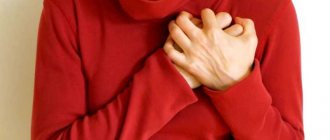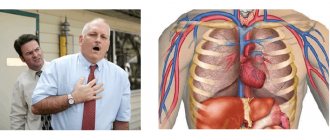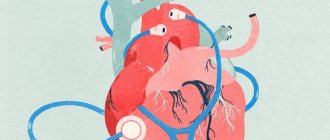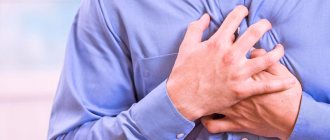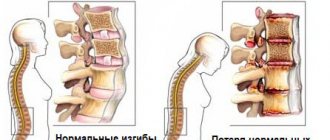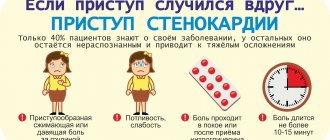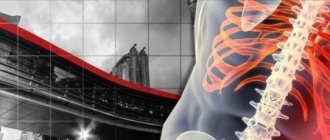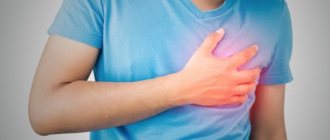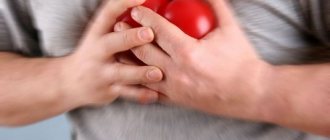Features of adolescence
During adolescence, the process of completing the maturation of all organs and systems in the body occurs. This is a stressful time, and it affects everyone differently. The answer to the question of why the heart hurts in 14-year-old teenagers is, in some cases, precisely the teenage period.
Why is this happening? During this age period, metabolic processes accelerate, weight and height actively increase. The body of a teenager is subject to increased stress, which appears as a result of exposure to the following factors:
- blood vessels grow faster, the heart “cannot keep up” with such accelerated development;
- the thyroid gland and pituitary gland are actively functioning;
- tachycardia may result from changes in the autonomic part of the nervous system;
- body weight increases, bones actively grow and strengthen, which makes the heart muscle work faster.
It is also often noticed that children between the ages of 12 and adulthood are emotionally unstable. This is due to the fact that the central nervous system completes the formation process, so during this period the state of the cortex and subcortical structures changes.
Heart failure in adolescence: myth or reality. What measures should parents take?
Today we want to talk with parents about their children, or rather about the “heart” problems of their children who are in adolescence or adolescence. No, don’t think about it, we will not talk about love affairs, which are already relevant for children of this age category, but about problems related to heart health. In this article, we propose to understand why adolescents may experience cardiac problems, what symptoms accompany them, what to do in such a situation and how to prevent it.
Physiological reasons
Most often, the reason that a teenager’s heart hurts is precisely a physiological factor, that is, the characteristics of the body’s development during this period of growing up. If a teenager was not bothered by painful sensations in the heart area until he was 10-12 years old, and suddenly he began to complain of dull pain, this may be evidence of incomplete closure of the mitral valve. If you consult a cardiologist in a timely manner, the problem can be easily solved.
Teenage girls may complain of breast pain before the start of their menstrual cycle, which is also a normal physiological process at this age.
Pain in the heart area may also appear after an infectious disease, sore throat or flu, since during adolescence the child’s protective functions of the body are reduced. These symptoms can go away on their own, but most often they develop as complications. This requires diagnosis and treatment by a specialist.
Among the physiological factors, cardiologists also note a lack of carnitine, which is responsible for transporting nutrients into the cell. This condition is easily corrected.
Nature of pain and pathology
It is important to consider in more detail the main causes of heart pain, which are associated with pathological processes in the body. The strength and severity of sensations, the time of its appearance and the provoking factor play an important role in diagnosis.
Stitching pain usually occurs in the following cases:
- pressure changes due to dystonia;
- neurosis;
- penetration of air into the pleural cavity of the left lung;
- pericarditis;
- rachiocampsis;
- heart disease, myocardial dystrophy, coronary blood flow disturbance.
Pressing pain in the left chest often accompanies severe abnormalities and may be a sign of:
- pericarditis;
- myocardial ischemia;
- aneurysms;
- congenital abnormalities in the structure of valves and coronary vessels.
It is important to understand that children who complain of heart pain are not always just trying to attract the attention of their parents. It cannot be ruled out that the child is telling the truth. In this case, it is best to play it safe and undergo a full examination.
Pathological factors that provoke heart pain
If a teenager often has heart pain or the pain does not go away for a long time, this may indicate the presence of a disease. It can be localized both in the heart and in other organs.
Cardiologists identify the following pathological causes of pain in the heart area:
- neurocircular dystonia – disturbances in the functioning of the nervous and endocrine systems affect the functionality of blood vessels and the heart;
- disturbances in the circulatory system, especially in those arteries that supply blood to the heart muscle;
- heart defects;
- changes in the heart muscle, which may be the result of an infection;
- curvature of the spine when the sensitive fibers of the spinal cord roots are pinched or inflamed;
- neuralgia, neuroses;
- disturbances in the gastrointestinal tract (gastritis, duodenitis).
Sometimes it is also possible that there is both a physiological and a pathological cause in the body, which can provoke pain.
Specifics of the pathology
With an accelerated metabolism, at approximately the age of 14, the child experiences more intense stress on the heart muscle, which responds with pain in the chest and other unpleasant symptoms. The most common cardiac disorders in adolescents are the so-called juvenile and drip hearts.
Juvenile heart refers to changes in the heart area during puberty that are not related to heart disease. Previously, the cause of this pathology was considered to be the accelerated growth of the child and the disproportion between it and the growth of the heart. Nowadays they are inclined to believe that the problem lies in endocrine disorders inherent in the period of puberty.
The droplet heart, as this phenomenon is also called, is distinguished by its reduced size, as well as its elongation (droplet-shaped), downward displacement, and adoption of a vertical position due to the lowered diaphragm. This problem often occurs in asthenic teenagers who grow very quickly. A drop heart is also called a small heart because it does not meet the standard size for its age.
Symptoms
In order to find out why a teenager’s heart hurts, cardiologists first examine the existing symptoms. It can be different depending on the cause of the development of pain and the condition of the teenager.
Cardiologists identify the following main symptoms:
- stabbing and periodic pain in the heart area, which is not accompanied by pathology, but the child is emotionally unstable (in this case, the cardiologist will advise reducing physical activity and the pain will go away on its own);
- discomfort or squeezing pain - this may indicate the development of ischemia, perhaps even congenital pathologies;
- pain in the heart, swelling of the lower extremities, shortness of breath, bluishness of the skin - possible presence of heart disease;
- if your heart starts to hurt after eating, it means that the problem lies precisely in the gastrointestinal tract.
When to go to the doctor urgently
In many cases, suspicious symptoms cannot be ignored, as they can lead to serious consequences. You should definitely seek medical help if you have the following symptoms:
- Pain in the heart occurs regularly, does not change in nature, but its intensity and frequency increase.
- Discomfort is accompanied by pale skin, weakness, pre-syncope or fainting.
- The teenager loses weight for no apparent reason and constantly feels weak and fatigued.
- The patient has had an elevated body temperature for a long time in the absence of obvious signs of an infectious process.
- Against the background of heart pain, shortness of breath, swelling, rapid heartbeat, and a feeling of interruptions in the functioning of the heart appear.
- Heart pain began after a sore throat and is combined with inflammation and pain in the joints.
Important!
If the condition worsens suddenly - the heart rhythm is disturbed, severe shortness of breath or loss of consciousness occurs - this is a reason to call an ambulance team.
When should you see a doctor?
If your heart hurts in adolescence, you should not draw hasty conclusions. Some parents begin to panic and think about the development of heart disease in their child. But such a diagnosis can only be made by a specialist after a comprehensive examination. After all, such a pathology is usually detected in the first year of a baby’s life, but there are exceptions.
In any case, when there are painful sensations in the heart area that periodically occur for no apparent reason, it is better to see a cardiologist. He will diagnose and prescribe appropriate treatment.
Recommendations for parents from a pediatric cardiologist at the Center for Medical Research. What should parents listen to?
It is very important that the child alternates intellectual and physical activity. For example, after completing homework, it is not recommended for a teenager to play computer games; it is better to play outdoor games with peers.
As for additional physical activity in the form of additional sections, swimming, skiing, rowing, etc. would be an excellent choice. Parents should understand that they should not completely exclude physical activity for their child in order to protect or protect him. It is important to understand that a lack of physical activity in adolescents contributes to a decrease in the speed of blood circulation, which ultimately leads to poor nutrition of the heart. This can cause a decrease in the tone of the heart muscle. Remember that the heart is a muscle, and if it, like any other muscle in our body, is not stressed, it will gradually atrophy.
Take care of your child and take him to a pediatric cardiologist as a teenager, even if there is no particular reason for this. Remember this expression: “Forewarned is forearmed.”
Make an appointment by phone: +380; +380 (57) 703-62-24; +38
.
What to do?
In order to identify the reason why a teenager’s heart hurts, a cardiologist performs a number of diagnostic procedures.
What to do if you have heart pain?
- To begin with, it is worth identifying whether the teenager is at risk, that is, whether he has a history of heart pathologies. This category includes children who often suffer from sore throats, colds, or constant headaches. These are also teenagers who are overweight or, conversely, underweight, or those who are growing rapidly.
- It is worth finding out whether the teenager has a curvature of the spine, which can also interfere with the functioning of the heart.
- At a certain period, preventive examinations by specialists are prescribed. It is important not to miss them.
If a teenager has a pinched heart after some stressful situation, it is worth giving sedatives, and it will go away, according to the advice of cardiologists. Experts also insist that between the ages of 10 and 12, hormonal changes occur, so pain may be associated with physiology.
But it is important to undergo examination by a cardiologist, since pathologies can have a hidden form. For example, vegetative-vascular dystonia, rheumatism or viral myocarditis. They can develop either independently or as complications of previous diseases.
Heart disease in children
Heart diseases can be congenital or acquired. Most congenital pathologies are diagnosed at the fetal stage of development of the baby. Many of them can only be eliminated with the help of surgeons.
Acquired ones can occur regardless of age. The reasons for this can be different: from an infection in childhood to illness of the mother during pregnancy.
Common diseases of the cardiovascular system (CVS):
- Arrhythmia. A pathological condition of the heart in which there is a disturbance in the rhythm, contraction and sequence of excitation of the heart muscle. The disease can appear regardless of age, often after serious disorders of the nervous system. Arrhythmia also occurs in healthy children. It is noted against the background of physical activity, under the influence of heat or strong emotional shocks.
- Vegetative-vascular dystonia syndrome (VSD). Diagnosed due to a pronounced whole complex of various symptoms. It manifests itself in children in the form of cardiac, respiratory, neurotic syndromes, vegetative-vascular crises, and thermoregulation disorder syndrome. To treat VSD in children, medications, physiotherapy, and psychological methods are used.
- Defects and anomalies in the development of the cardiovascular system. Such problems appear even at the intrauterine stage of development. Negative external factors that affected a woman during 4-8 weeks of pregnancy (previous viral diseases such as influenza, rubella, chronic diseases, work in hazardous industries, drug treatment, hereditary factors, bad habits) have a great influence.
Read also
How to use Indovazin for hemorrhoids - treatment regimen and composition
The number of children suffering from heart disease is increasing every year. Stressful conditions, poor quality nutrition, poor environmental situation - all this negatively affects preschool children. Many of them become disabled. Everything is aggravated by the fact that the child cannot clearly express his complaints, so most diseases are diagnosed only during an examination by a doctor.
You should not skip routine pediatric examinations.
Diagnostics
What to do if a teenager has heart pain, only a cardiologist will tell you after a series of diagnostic procedures.
In case of periodic or constant pain, both adolescents and adults are prescribed the following types of diagnostics:
- ultrasound examination of the heart area (in this case, the diagnostician determines how the heart visually looks and whether there are any changes in its shape);
- ECG - determines how well, correctly and functionally the heart works;
- measuring blood pressure (in case of high values, it can affect the functioning of the heart muscle);
- X-ray of the thoracic and cervical spine;
- gastroduodenoscopy (disturbances in the functioning of the gastrointestinal tract can cause pain in the heart area);
- a general blood and urine test to identify other pathologies or inflammatory processes occurring in the body.
If necessary, the cardiologist can prescribe consultations with other specialists. And only on the basis of a comprehensive examination is therapy prescribed.
Extracardiac causes of cardialgia
Pain felt like heart pain can also occur with diseases of other body systems. Their localization may not coincide with symptoms due to the large number of nerve pathways connecting the heart and internal organs. Such reflex pains cause:
- osteochondrosis of the thoracic spine,
- inflammation of the pancreas or gallbladder,
- peptic ulcer,
- colitis and enteritis,
- esophageal spasm,
- pneumonia, pleurisy,
- intercostal neuralgia, herpetic infection,
- hyperthyroidism.
Advice from a cardiologist to solve the problem
If a teenager has heart pain every day, then the cardiologist, after diagnosing and determining the diagnosis, prescribes therapy. It can be medical or surgical. If the painful sensations are periodic, then sedatives are prescribed to reduce emotional stress, and recommendations are given regarding a healthy lifestyle.
Therapy for heart pain without taking medications involves avoiding stressful situations, conflicts, and establishing a sleep schedule. Also, physical activity should be moderate. In case of serious pathologies, playing sports is unacceptable. Nutritional correction also occurs. It should be a gentle diet, light food rich in nutrients.
It is worth knowing that potassium, calcium and magnesium are responsible for the functioning of the heart, the reserves of which in the body must be constantly replenished, according to the advice of cardiologists. They help strengthen blood vessels. So, seeds (pumpkin, sunflower, sesame), red beans, lentils, buckwheat porridge, spinach and cucumbers are sources of magnesium in the body.
Potassium is found in fresh orange juice, beets, bananas, oatmeal, dried apricots and melons. Calcium in soybeans, poppy seeds, sesame seeds. Caffeine is eliminated from the diet, sugar and salt consumption is reduced.
If a cardiologist prescribes drug therapy, then these may be antiarrhythmic drugs that enhance metabolism in the tissues of the heart and normalize the balance of electrolytes.
Why does the heart hurt in teenagers and which doctor should I contact?
The heart is the most important organ that participates in almost all vital processes of the human body. This organ is often compared to a motor, the operation of which determines the overall state of health. When pain and sharp tingling sensations occur in the chest area, this causes people to worry about possible heart pathologies. Of course, it is not necessary that pain and tingling in the heart are caused by any disease. In principle, there can be many reasons why the heart hurts.
4 Cardialgia is a painful condition accompanied by tingling in the chest area (left side). Most often, such a condition is not a separate disease; it is most likely intended to warn a person about other existing or developing pathologies. Sometimes, the provoking factor for cardialgia is diseases of the spine or inflammation of the heart muscle (myocarditis). 5 Cardiomyopathy - is expressed by disruptions in the heart rhythm. In this case, the patient experiences sharp stabbing heart pain. Most often, inflammatory pathologies of the myocardium are called cardiomyopathy. This condition leads to disturbances in the functioning of the heart muscle. 6 Pericarditis is a disease in which the outer lining of the heart (pericardium) becomes inflamed. There are several reasons contributing to this pathology. The main factors of pericarditis include the infectious nature of the disease and various autoimmune diseases. Signs of the disease show themselves especially clearly when the pathology becomes acute. The patient experiences a sharp stabbing pain in the upper chest. 7 Angina pectoris - this pathology is one of the obvious manifestations of coronary heart disease. Angina pectoris contributes to the accumulation of large amounts of cholesterol in the coronary arteries. As a result, blood does not flow to the heart muscle in the required volume. Due to disturbances in the blood supply to the heart, a person experiences aching, stabbing heart pain. Angina pectoris is often confused with cardialgia, but there are differences in the symptoms of these diseases. Determining them yourself will, of course, be a difficult task. But timely diagnosis and medical consultation will help to make an accurate diagnosis. Angina pain is sometimes accompanied by a burning sensation and heaviness in the chest area. 8 Spasms - convulsions of the heart muscles. Cramps appear due to various bad habits. Excessive consumption of tobacco products, alcohol abuse and frequent stress provoke this pathology. Although at the moment medicine cannot name the exact reasons for the narrowing of the lumen of the arteries, the majority of clinic patients suffering from heart spasms are, as a rule, people who do not limit themselves to smoking and drinking alcohol. 9 Intercostal neuralgia is one of the most common causes of heart tingling and pain. Pathology appears due to pinching or irritation of the intercostal nerve. Most often, elderly and elderly people suffer from this disease, but the younger generation also falls under the influence of intercostal neuralgia. One of the obvious reasons for the development of the disease is a sedentary lifestyle.
Prevention of heart disease
In order not to wonder why a teenager’s heart hurts, it is worth knowing and resorting to preventive measures, on the advice of cardiologists.
- When the first pain in the heart area of an undetermined nature appears, you should undergo examination by a cardiologist. In the early stages, disorders are easily treatable.
- Colds are treated under medical supervision to avoid negative consequences in the form of complications on the heart muscle.
- Children who are overweight or underweight are at risk.
- A normal emotional state and a warm atmosphere in the family are the key to a child’s health.
- Even children with pathologies should exercise moderately. Otherwise, the muscles may atrophy.
- The diet is the maximum amount of nutrients that a child receives that he needs for normal development.
Symptoms of problems in girls and boys
Signs of NCD are not specific; they can also be present in the early stages of more serious cardiac disorders. For adolescents, diseases of the heart of an inflammatory nature that arise as a consequence of the flu or a common sore throat or pneumonia can be dangerous. In such cases, the following complaints are added to the listed complaints:
- interruptions in the rhythm of contractions,
- severe weakness
- attacks of suffocation,
- joint pain,
- body temperature rises, but only slightly,
- blood pressure drops,
- blood circulation is impaired,
- swelling increases.
Watch the video about the causes of heart pain:
How to protect yourself from heart attacks?
In order not to wonder why a teenager’s heart sometimes hurts or why he suffers from rheumatic attacks, it is worth monitoring changes in the heart muscle. Consultation with a doctor and courses of treatment will help reduce such attacks and the possible development of irreversible consequences to a minimum.
It is also worth knowing that a lack of vitamins or lack of sugar can have a bad effect on the functioning of the heart muscle.
In most cases, pain in the heart area in adolescents 13-15 years old is easily treatable. It is important for parents to be attentive to their children and pay attention to the slightest changes in well-being.
Heart of a child - Youthful heart
Youthful heart
In children's clinics and at appointments with the school doctor, you can often see teenagers complaining about their heart. They may be bothered by palpitations, discomfort in the heart area, sometimes a feeling of “squeezing”, shortness of breath during physical exertion, headache, dizziness, excessive sweating, chilliness of the hands and feet, and these symptoms occur in a variety of combinations.
Quite often, these adolescents experience rapid growth; in one summer or one year they “stretch out” so much that they cause surprise.
During the examination, the doctor finds in such children moist skin, a bluish coloration of the hands and feet, as if they were wearing blue gloves and socks; fast or slow heart rate; high or low blood pressure; certain changes in the heart. In some children, the temperature rises slightly in the evenings to 37.0-37.2°, but subsides after a few hours.
As if there were signs of serious illness. But some time passes, and all complaints, all signs of changes in the heart disappear, even if no treatment was used. At the next examination, the doctor confirms that the heart is absolutely healthy. What's the matter? Was the malaise caused by rheumatism, some other serious illness, or was it something else? Why can heart problems in some children go away without any treatment? How to deal with teenagers in such cases? Let's try to answer these questions.
Read also
Features of the composition of coffee and its effect on cholesterol levels
The age of 11-15 years is one of the important periods of growth and development of the child’s body. During these years, puberty begins, accompanied by a number of complex phenomena characteristic of adolescence. At this time, very significant changes occur in the body of children, as a result of which a boy turns into a young man, and a girl into a girl.
The restructuring of the nervous system and endocrine glands that occurs during adolescence manifests itself in a variety of symptoms. Some children experience very strong growth. Over the course of a year, they become 10-15 centimeters taller. This increase in height is mainly due to the lengthening of the arms and legs. As they say, teenagers become “lanky.”
At the same time, ossification processes occur rapidly. When a child reaches this age with any changes in the bone apparatus, they can easily become fixed if appropriate corrective physical exercises are not applied.
And the body, as if understanding what it needs, “looks for a way out” in physical activity, mobility, fast movements, running.
At this age, instability, slight excitability and fatigue of the nervous system are observed, and this quite often causes a sharp change in mood. Some children have unbalanced behavior, sharp, angular manners; disruptions in behavior and attitude towards family, friends, and comrades.
All changes that occur in the body during adolescence affect the heart and blood vessels, the result of which is disturbances in the circulatory mechanism, disorders called “adolescent heart”. This is not a disease, but a kind of “growing pain.”
Manifestations of “youthful heart,” of course, are not observed in all adolescents, and, in addition, they take different forms in different children.
At this age, the heart grows especially rapidly. So, if over seven years - from 7 to 14 - it increases in volume by 33%, then over the next two years - from 14 to 16 years - it increases by 60%.
The rapid growth of the heart in some children leads to a change in its shape - it increases slightly in size (this phenomenon is called juvenile enlargement, or cardiac hypertrophy). Such an increase in size sometimes gives reason to suspect a heart defect, but a thorough and attentive examination, as a rule, does not confirm this.
Heart enlargement is much more common in boys than in girls. Such teenagers have good physical development and sometimes look older than their age. They usually complain little or not at all.
There are also other manifestations of the “youthful heart” - the so-called “small” or “drip” heart. It develops when a sharp growth spurt occurs in a short time, and the heart does not seem to keep up with this leap. The size of the heart becomes small compared to the size of the body.
This form of “youthful heart” is equally common in boys and girls. They are usually tall, have a narrow chest, poorly developed muscles and subcutaneous fat. These teenagers present a variety of complaints, and upon examination the doctor finds a number of changes in their heart and blood vessels.
The transitional age is often the most difficult for children, parents, and teachers. In order to painlessly bring a teenager out of these difficult conditions for him, caused by rapidly occurring physiological transformations, a lot of effort must be made. But is medical intervention necessary in such cases?
Considering that such functional disorders of the cardiovascular system are associated with adolescence, no special drug treatment should be prescribed to these adolescents. What to do with such children? First of all, you need to create a daily routine that would have a stimulating effect on the central nervous system. The basis of this regime is the correct alternation of work (school classes) and active rest with essential physical exercise. Morning hygienic exercises, walks, doing housework, excursions, tourism, swimming, rowing - all this should certainly be included in the daily routine of such a teenager.
Regular wiping and dousing are very useful for such children.
Meals should be nutritious, including foods rich in vitamins, and certainly regular, at the same hours.
During this period of life, it is especially important for a teenager to be in a cheerful, good mood, to have faith in one’s strengths and to be confident that health problems are transient and temporary.
These simple and accessible measures can be carried out in any conditions, and they are quite sufficient to gradually eliminate functional disorders completely.
However, only a doctor can determine what exactly causes disturbances in the functioning of the heart. Such violations are not always purely age-related. They can arise due to certain diseases, and then the measures to combat them will be different.
It is known that the best type of defense is offensive. This truth is also true for medicine. Seeing the first signs of an emerging disease in time, stopping the disease at this stage and curing it - this is the proactive tactic that doctors are now striving for. When it is possible to implement it in practice, treatment becomes preventive in the full sense of the word.
And parents can provide significant assistance in this.
We must firmly remember that the mother and father, by protecting their health, ensure the health of their future children. Healthy parents - healthy children - an irrefutable law of life on earth. The foundation of human health is laid in utero and at birth. And if a child happens to get sick, then the parents’ first duty is to notice the slightest deviation in health and immediately seek medical help.
In the following sections we will talk about diseases that most often cause disorders of the cardiovascular system in children.
Conclusion
Why the heart hurts in teenagers is an age-old question that torments many parents. Cardiologists advise seeking advice when the first pain appears, since pathologies and abnormalities in the functioning of the heart muscle can be avoided. As a preventive measure, experts focus on a normal emotional state, regular physical activity and proper and healthy nutrition.
Consequences and complications
The consequences and prognosis depend on the disease that caused cardiac pain syndrome. The most dangerous conditions are coronary heart disease, cardiomyopathy, endocarditis, rheumatic carditis. Their possible complications:
- Heart failure;
- Formation of heart disease;
- Thromboembolism;
- Sepsis;
- Myocardial infarction.
Without proper treatment, these conditions can be fatal. That is why it is important to identify pathology as early as possible. If persistent chest discomfort occurs, it is better to play it safe, consult a doctor and undergo a medical examination.
Peculiarities!
Even harmless, at first glance, NCD can lead to serious consequences in the form of arrhythmia and hypertension.
Diseases of the cardiovascular system in children and adolescents
As a rule, to find out the real source of pain, it is enough to simply ask the right questions to the patient.
Some of the most important symptoms are chest pain during exercise and chest pain accompanied by dizziness. If these complaints are identified, a more thorough examination is necessary. In most cases, the cause of such pain is anxiety, excessive caffeine consumption, asthma, muscle strain, or Tietze's disease. High blood pressure (hypertension) and high blood cholesterol (hypercholesterolemia)
Doctors used to think that high blood pressure in young people was almost always a complication of another disease, such as kidney disease. We now know that even infants can develop primary hypertension, also called hypertension. Abnormally elevated cholesterol levels are also sometimes observed in adolescents. This problem can lead to heart attack, stroke, kidney failure, blindness or other adverse conditions.
Dizziness and/or headache with increased blood pressure may suggest primary hypertension. However, hypercholesterolemia (high cholesterol) does not cause significant symptoms in adolescents.
How to diagnose hypertension
and hypercholesterolemia?
Diagnostic measures include:
- physical examination;
- a carefully collected medical history;
- blood pressure study;
- determination of cholesterol levels in the blood.
If abnormally high blood pressure readings are detected in adolescents, repeat testing is required at subsequent visits before a definitive diagnosis can be made.
The top number in a blood pressure measurement represents systolic pressure: the peak pressure in the blood vessels when the heart contracts. The second number expresses diastolic blood pressure, which is reached when the heart relaxes between beats. If blood pressure remains elevated during subsequent measurements, then more extensive laboratory tests and ECG (electrocardiography) are necessary.
Reminder for parents: Stress can contribute to the development of hypertension, so you should know what your child's blood pressure is recently?
Help teenagers become healthy adults
All young people, whether they have hypertension or not and whether they have hypercholesterolemia or not, should:
- maintain a healthy weight;
- do aerobic exercise at least 30 minutes a day;
- refrain from using tobacco and alcohol;
- Learn stress-relieving techniques—exercise, deep breathing, or meditation;
- Contact your pediatrician if your underage girl plans to take birth control pills. Although taking oral contraceptives is not contraindicated for healthy people, this process needs to be monitored: find out whether it increases blood pressure and cholesterol levels in the blood.
published 09/29/2015 16:54 updated 10/06/2015 — Heart and vascular diseases
In the educational and training process with high school students students of the preparatory educational department, special restorative and preventive training is used. First of all, it is aimed at increasing the functional capabilities of boys and girls. As studies have shown, in terms of quantitative ratio, cardiovascular (CV) diseases occupy first place among all adolescent ailments and amount to 35.9%. It should be added to this that 83-85% of adolescents have unsatisfactory performance in functional tests. The main diseases of the cardiovascular system are:
- mitral valve prolapse (MVP), accounting for 47.1%,
- in second place is neurocirculatory dystonia (NCD) - 26.8%,
- in the third place - vegetative-vascular dystonia (VSD) - 17.9%.
Heart disease in teenagers
MVP is a disease that involves bulging of the heart valve leaflets when they close in the opposite direction. This condition can be observed when there is a defect in the structure of the special fibers that hold the valve leaflets. Under various pathological conditions, the tendon threads that operate the valve relax, become overstretched, and a condition called MVP occurs. The blood in the left ventricle of the heart is pushed into the aorta, and since this process occurs under pressure, the overstretched tendon threads are unable to keep the valve leaflets in proper tone and the valve seems to bend.
Adolescent diseases VSD or NCD combine various conditions that develop in young people as a result of disturbances in the nervous regulation of vascular tone. VSD syndrome usually occurs after infectious diseases such as influenza, adenoviral infections, certain diseases of the nervous system and is characterized at the first stage by an increase (above 130 mm Hg) or decrease (less than 105-100 mm Hg) in blood pressure (BP). ), increased irritability and fatigue, decreased overall performance, sleep disturbance. These are the main signs of heart disease in adolescents.
Causes of pathology
In a growing child, the size of the heart in relation to the entire body area is imperfect; in addition, the intensive growth of the myocardium outstrips the lumen of the coronary arteries, which provokes temporary coronary insufficiency.
The result is relative ischemia of the heart with cardialgia of various types: pressing pain in the heart of varying intensity and frequency occurs. There is a pulling in the middle of the sternum, the heart begins to tingle at times, it aches, it burns behind the sternum, and heaviness arises.
At the same time, fluctuations in blood pressure and systolic murmurs are recorded. The active growth of the teenage body also leads to a lag in the maturation of the nerve fibers innervating the myocardium, which is manifested by disturbances in heart rhythm and changes in the properties of its conduction system.
The causes of deviations from the norm are different, but the main ones are of cardiac origin; they can traditionally be divided into physiological and pathological.
The first ones are harmless, are a variant of the norm, occur more often in asthenics and are characterized mainly by stabbing pain in the heart. They go away on their own, without additional intervention.
The second are symptoms of an existing somatic pathology in a teenager; unpleasant sensations in the chest require special correction of the underlying pathology.
- insufficient cardiac muscle mass;
- a sharp increase in myocardial volume due to puberty with a maximum of testosterone;
- imperfection of the autonomic nervous system;
- asthenic physique, when the axis of the heart is in a vertical position (extended legs, arms, chest);
- thyroid dysfunction, especially in iodine-deficient regions;
- genetic features
- congenital coronary anomalies;
- inflammation of the pericardium;
- VSD;
- previous infections with dystrophy of cardiac structures of various types;
- valve defects (congenital in adolescents), latent, detected by chance or already in the stage of decompensation
Separately, it is necessary to mention VSD (vegetative-vascular) or neurocirculatory dystonia (NCD) - this is a borderline state between normality and pathology. It accounts for about 80% of all cardialgia that occurs in adolescents.
The essence is a failure of nervous regulation against the background of neurosis, hereditary predisposition, and hormonal changes. The hyperreaction to stress is explained by the suppressive influence of the sympathetic nervous system to the detriment of the parasympathetic, which provokes hyperactivity of the fragile heart muscle with the occurrence of heart pain, in this case most often of an aching or stabbing nature. The reason may be:
- foci of focal and perifocal infection in a teenager (tonsils, otitis, caries);
- poisoning, intoxication of various origins;
- viral infections;
- injury or surgery (weakened immune system);
- overwork;
- bad habits;
- physical inactivity;
- insomnia;
- computer addiction.
VSD (NCD) is cyclical, the attack begins with shortness of breath, tachycardia, hyperhidrosis of the palms, tremors of the hands, pain in the heart, radiating to the arm and shoulder blade on the left. Presyncope and loss of consciousness may occur. Blood pressure fluctuates like a pendulum, and migraines develop. The reason is stress or overwork, the attack goes away after a few minutes or hours. Severe symptoms require medical attention.
In addition to cardiac causes that cause pain in the left half of the chest, there may also be extracardiac:
- intercostal neuralgia;
- shingles;
- osteochondrosis or spinal injury;
- neuroses of various etiologies;
- Digestive problems.
Sometimes cardialgia in a teenager is caused by a whole complex of reasons. Finding out the etiology of chest pain is a doctor’s primary task, since the normal development of a person’s cardiovascular system, which determines the state of his health and life expectancy, depends on this.
Clinical manifestations depend on the cause of cardiac discomfort. The main symptoms are presented in the table.
Prevention
Prevention of heart pain in adolescents is very important, and it mostly lies in balancing the child’s lifestyle, physical and mental stress.
Playing sports at a young age is beneficial for all body systems. Sports such as running and swimming are well suited for the development of the chest, which is very important for the proper formation of the cardiovascular system.
Nutrition also plays a fundamental role in the full development of a young body. Here you need to follow a special system:
- Eliminate unhealthy but popular foods among young people from your diet. These include fast food, sweets and other things containing a lot of sugar, fat and carbohydrates.
- Fill your child's diet with magnesium and potassium. They are responsible for maintaining stable heart function. Bananas, dried fruits, watermelons, beets, and wheat sprouts are rich in these elements.
- Maintain proper levels of calcium in the menu. Fermented milk products, eggs, seaweed, oatmeal and buckwheat porridge are great for this.
- Don't forget about phosphorus and vitamin D. They help ensure the stable flow of many vital processes. There are a lot of them in fish oil, cod liver, cheese and nuts.
Adolescence is convenient because at this time it is still quite easy to adjust your lifestyle, habits, rest and sleep patterns, regulate and find the optimal value for mental and physical activity. This way, without medical intervention, you can restore your health and maintain it at the proper level, which is the key to success and peace of mind for any mature person.
Treatment process
Depending on the diagnosis, appropriate therapy is prescribed. In some cases, surgery may be necessary. Most often, you can get rid of heart pain by following the treatment prescribed by your doctor, which may include the following measures:
- correction of a teenager’s lifestyle;
- taking medications;
- physiotherapy;
- psychotherapy.
As is the case with the elimination of any pain and its causes, therapy for heart pain in adolescents is varied and includes medication, the use of folk remedies and some alternative methods.
Drug treatment
Aching and dull heart pain that occurs suddenly or intermittently is usually localized in the upper part of the heart region or under the left nipple. To combat such pain in medicine, there are many means, among which it is customary to highlight:
- sedatives (Corvalol, Valocordin, etc.);
- painkillers (analgin, sedalgin, pentalgin and the like, they are usually used for heart pain that continues for a long time);
- additional soothing tinctures (motherwort, valerian, hawthorn).
All of these are standard medications for heart pain in people of all ages. For adolescents, their dose and order of administration should be adjusted according to the doctor’s instructions, if no other drugs were prescribed in the course of therapy.
Folk remedies
Traditional medicine, like scientific medicine, has a wide range of treatment and prevention of heart diseases. Each method of stabilizing and strengthening human health has its own characteristics, and it should be used only after the approval of a cardiologist.
People with heart problems usually use various juices for prevention purposes, the most effective of which are lemon, cranberry, currant, beet and carrot.
Among the many folk recipes for pacifying heart pain, the following are especially popular:
- Tincture of lemon balm leaves . The leaves of the plant must first be dried. For a liter of boiling water, 7 tbsp is enough. l. dried leaves. This tincture should be taken half a glass 3 times a day; it helps well with heart pain and shortness of breath.
- Walnut tincture with vodka . For a liter of alcohol, 30 unripe, finely chopped fruits are enough. It is infused for 2 weeks, consumed 3 times a day, 20 drops for a month.
- Rosehip root tea . 1 tbsp. l. crushed plant root is poured with 1 cup of boiling water. It is enough to boil this tea for a quarter of an hour over low heat. It is better to consume it warm, 3 times a day for 2 weeks.
- Lemon peel . Simply chewing a lemon peel will be beneficial for the cardiovascular system.
- Fir oil . For heart pain, people recommend rubbing this oil in the area of the left nipple for several minutes to improve well-being.
- Foot baths with mustard. 15 minutes in such a bath will relieve heart pain. It would also be good to put mustard plaster in the chest area, where heart pain is felt especially strongly.
These are just a few examples of folk remedies designed to improve health in case of heart pain.
Alternative options
For heart pain in children, it is not at all necessary to take medications and try traditional methods; to eliminate the cause of discomfort, it will be enough to correctly adjust the daily routine. The following are very important:
- Complete rest . Walking in the fresh air and getting enough sleep are fundamental factors at this point.
- Reducing mental stress . Avoiding various stresses and conflicts will be the best way to reduce the load on the not yet fully strengthened psyche of a young body.
- Reduced physical activity . It is necessary to balance such loads in order to feel comfortable after them; they cannot be completely excluded.
- Water treatments . Contrast showers, rubbing down to the waist, sea bathing - all this has a positive effect on the maturing body.
To strengthen the results of treatment and adjust life routines, as well as to avoid recurrence of heart problems in the future, children should take measures to prevent such conditions.
Why does my child have a stabbing or pain in the heart area?
- Common reasons
- What to do?
One of the most common reasons for visiting a pediatric cardiologist is the child’s pain in the heart area. In most children, such pains are stabbing in nature, but they can also be pressing or pulling.
They are often detected by the child in the area where the apex of the heart is located. In 80% of cases, the appearance of stabbing pain is preceded by a stressful situation.
Most pain in the heart in childhood is not associated with physical activity and does not radiate to other parts of the body. If you distract the child's attention or give him a sedative, the stabbing pain often decreases or disappears altogether. Why can they appear in a child and is this really a sign of heart disease?
Most often, the pain that children and their parents mistake for heart pain is in no way related to diseases of this organ. They may be a symptom:
Symptoms that require you to see a doctor
Any discomfort that worries the patient is considered grounds for visiting a specialist. An approximate list of manifestations (can be used as a guide) is as follows:
- Chest discomfort. Any character, not only stabbing, but also aching, cutting, pulling, pressing. Moreover, if there are other signs of the process. Typically, for cardiac causes, the pain is of moderate intensity and intensifies with physical activity, work, and stress.
- Dyspnea. Violation of blood oxygen saturation leads to general hypoxia. The body does not receive enough substances. Fasting ends in tissue atrophy, this is dangerous because the heart itself is under attack. Everything can end in a heart attack, stroke and severe disability. And that's the best case scenario.
- Headache for no apparent reason. Caused by insufficient nutrition of the brain. The phenomenon occurs in approximately 15% of cases. Against the background of heart problems, this is an alarming sign.
- Vertigo. To the point of inability to feel the ground under your feet and complete disorientation in space. The functioning of the cerebellum is disrupted.
- Sweating or hyperhidrosis.
- Paleness of the skin.
- Cyanosis of the nasolabial triangle. The last two manifestations are 100% likely to indicate cardiac problems.
- Weakness, drowsiness, general symptoms. Most often found in cardiac pathologies. Complications are likely.
These are grounds for routine visits to doctors.
- Oral questioning of the patient regarding complaints. Already at this stage you can roughly understand what doctors are dealing with.
- Anamnesis collection. Family history, previous diseases, current somatic and other pathologies, treatment, if any, its duration, specific names of drugs. The vector of further examination is determined by these two methods.
- Listening to heart sounds. With cardiac problems, changes will always occur. Their absence is grounds for revising the probable diagnosis, although there are complex clinical cases.
- Measurement of blood pressure and heart rate.
- For the purpose of dynamic assessment, 24-hour monitoring is used using an automatic Holter programmable tonometer.
- Electrocardiography. Functional impairment, even minimal, will be noticeable. The main problem is the need for highly qualified diagnosticians and cardiologists.
- Echocardiography. Ultrasound technique. All organic disorders are visually determined.
- MRI or CT. If neoplastic or other pathologies are suspected.
- Angiography.
Causes of pain
If you take all the clinical cases and add a little theoretical knowledge, you can find out why the child has an unpleasant sensation in the heart area.
- Functional pain. Most often observed in primary schoolchildren and adolescents. At this time, the final formation and growth of organs occurs, and hormonal fluctuations occur.
- In adolescence, the symptom appears against the background of vegetative-vascular dystonia, due to pressure fluctuations.
- Cardialgia develops against the background of a viral or bacterial infection. With such diseases, the load on the heart increases (pulse increases, temperature rises). But in this case, I cannot exclude such a complication as myocarditis.
- I often met in practice children who complained of pain in the heart, but in fact they were diagnosed with pathologies of the spine, problems with digestion, and bile ducts. And the sensations on the left side of the chest were simply irradiation from the main source.
- The left chest may hurt after an injury or bruise.
- Finally, unpleasant sensations can be associated directly with diseases of the heart muscle, pericardium and blood vessels. In this case, a complete examination of the child’s heart is necessary (taking a dynamic cardiogram or monitoring it, echocardiography, general blood tests and biochemistry).
When an infant has a heartache, he will not be able to talk about it. But if the baby becomes lethargic, has difficulty latching on the breast, is choking, and at rest the pulse remains rapid, then this condition cannot be ignored. There may be a congenital defect or myocarditis.
Problems of adolescence and teenage diseases
In the educational and training process with high school students students of the preparatory educational department, special restorative and preventive training is used. First of all, it is aimed at increasing the functional capabilities of boys and girls. As studies have shown, in terms of quantitative ratio, cardiovascular (CV) diseases occupy first place among all adolescent ailments and amount to 35.9%. It should be added to this that 83-85% of adolescents have unsatisfactory performance in functional tests. The main diseases of the cardiovascular system are:
- mitral valve prolapse (MVP), accounting for 47.1%,
- in second place is neurocirculatory dystonia (NCD) - 26.8%,
- in the third place - vegetative-vascular dystonia (VSD) - 17.9%.
Heart disease in teenagers
MVP is a disease that involves bulging of the heart valve leaflets when they close in the opposite direction. This condition can be observed when there is a defect in the structure of the special fibers that hold the valve leaflets. Under various pathological conditions, the tendon threads that operate the valve relax, become overstretched, and a condition called MVP occurs. The blood in the left ventricle of the heart is pushed into the aorta, and since this process occurs under pressure, the overstretched tendon threads are unable to keep the valve leaflets in proper tone and the valve seems to bend.
